Phytotoxicity of pyridineamidoximes against two crop plants: preliminary evaluation
##plugins.themes.bootstrap3.article.main##
Abstrakt
The study involved the analysis of the impact of pyridineamidoximes on the germination and early development of plants belonging to different taxonomic units (monocots and dicots). maize (Zea mays) and sunflower (Helianthus annuus) were selected as the objects. Culture was carried out in vertical plastic PhytotoxkitTM containers (Phytotoxkit, Tigret company, Belgium). number of germinated seeds, root length and shoot height were recorded. Based on the results, germination index and percentage inhibition of roots and shoots growth were calculated. 2-, 3- and 4-pyridineamidoximes showed varied influence on the plants under study. Generally the toxic effect of pyridineamidoximes on the plants depends on both the position of the functional group in the pyridine ring, as well as on the concentration of the compound used. The results showed a higher susceptibility of sunflower vs. maize to the compounds. Phytotoxic response in maize occurred typically at the highest concentration (above 500 mg kg-1 d.w.s.), while the sunflower symptoms inhibition due to the presence of the test compounds occurred at the lowest (25 and 50 mg kg-1 d.w.s.) and the highest (1000 mg kg-1 d.w.s.) concentration.
##plugins.themes.bootstrap3.article.details##

Utwór dostępny jest na licencji Creative Commons Uznanie autorstwa – Na tych samych warunkach 4.0 Miedzynarodowe.
Autor udziela redakcji czasopisma Polish Journal of Agronomy (w skrócie: PJA) licencji niewyłącznej i nieodpłatnej na korzystanie z autorskich praw majątkowych do wersji papierowej/drukowanej i elektronicznej utworu Autora opublikowanego w PJA w kraju i za granicą, w całości lub w dowolnej części, w tym umieszczanie utworu w elektronicznych bazach/zbiorach danych lokalnych lub dostępnych w Internecie, przez czas nieograniczony na polach eksploatacji określonych w art. 50 ustawy o prawie autorskim i prawach pokrewnych.
Prace wydane w Polish Journal of Agronomy są udostępniane na licencji Creative Commons Uznanie autorstwa-Na tych samych warunkach 4.0 (CC-BY-SA).

